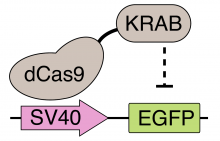BACKGROUND
Precisely controlled regulation of gene expression in cells, tissues, and organisms is one of the major challenges in tissue engineering, cell-based therapies, and gene therapy. Controlled gene expression in cells is achieved either by exogenously introducing cDNAs by transfection or viral transduction, or by introducing sequence-specific transcriptional regulators. These regulators include zinc-finger nucleases, transcription activator like effectors (TALEs), or enzymatically inactive Cas9 (dCas9) which are fused to transcriptional activation or repression domains to achieve the desired effect on gene expression. Of these techniques, CRISPR interference (CRISPRi) based on the fusion of inactive Cas9 (dCas9) to the Krüppel-associated box (KRAB) repressor, is a powerful platform for silencing gene expression. However, it suffers from incomplete silencing of target genes.
TECHNOLOGY
Inventors at the University of Toronto have developed a fusion protein that displays almost complete silencing of gene expression. Based on the CRISPRi platform, it is composed of dCas9 tethered to a ZIM3 KRAB domain (Figure 1). Guide RNAs direct binding of dCas9 to the targeted gene whereafter interaction of the KRAB domain with corepressor proteins prevents expression of the gene. The ZIM3 fusion is the most potent CRISPRi-based repressor and a significant improvement on existing platforms.
Figure 1. Repression of gene expression using a dCas9-KRAB fusion. dCAS9 is targeted to the gene of interest by corresponding guide RNAs, whereafter the KRAB domain is responsible for silencing gene expression. Of the many KRAB domains found in nature, ZIM3 displayed near complete silencing of gene expression.
COMPETITIVE ADVANTAGE
- Near-complete silencing of gene expression (~2-5 fold better than other CRISPRi platforms)
APPLICATIONS
- Gene therapy
- Epigenome engineering
- Genome-wide CRISPRi screens
INTELLECTUAL PROPERTY
- Provisional application filed (Aug. 2020)
PROJECT STATUS
Proof-of-principle studies have been conducted in two human cell lines (HEK293 and K562), where the repressive potency of 57 KRAB domains were screened. ZIM3 was identified as an exceptionally potent repressor and the ZIM3 KRAB–dCas9 fusion construct was demonstrated to be considerably more efficient than existing platforms at gene silencing (Figure 2). The ZIM3 fusion was subsequently also demonstrated to be better at suppressing the toxicity of Diphtheria toxin and better at distinguishing effects in genome-wide screens than other CRISPRi platforms.
Figure 2. Gene silencing of the ERK1 gene by CRISPRi using dCAS9 tethered to various proteins including a nanoluciferase (NLuc) control, previously published KRAB repressors (KOX1 and KOX1-MeCP2), and ZIM3. Gene expression is silenced by 2 to 3 times as much upon use of ZIM3.





